Issues
Four mints issued Maximilian coinage
Mexico City
This mint issued Ic (1864), 5c (1864, 1866/4, 1866), 10c (1864, 1866/4, 1866/5, 1866), 50c (1886), $1 (1866, 1867) and $20 (1866).

1c Mexico City
For varieties, see The Defiant Snake Variety of the 1864 Mexican Imperial Centavo.
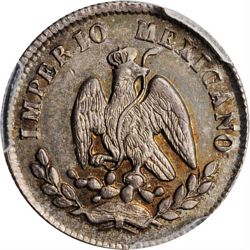

KM-386.1 10c Mexico City (Stack’s-Bowers Auction, 19 January 2021, lot 24234)
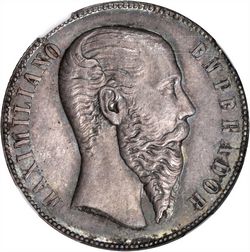
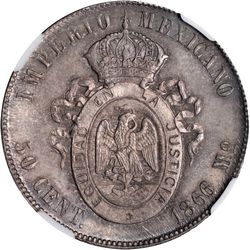
KM-387 50c Mexico City (Stack’s-Bowers NYINC Auction, 20 January 2022, lot 2100)
$1
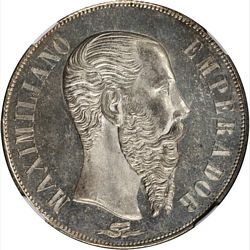

KM-388.1 1866 $1 Mexico City (Stack’s-Bowers Baltimore Auction, 6 November 2013, lot 21146)
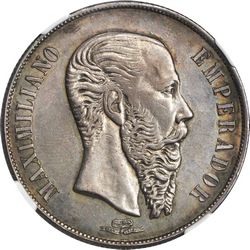
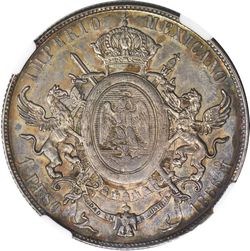
KM-Pn100. 1866 $1 Mexico City pattern, small letters (Stack’s-Bowers NYINC Auction, 14 January 2014)
The small-letters 1 Peso 1866-Mo and the 20 Pesos 1866-Mo are notoriously better finished than the other issues, often showing proof like surfaces and an unusually strong strike. Pioneering author Betts wrote on the small-letters Peso: “they are recognizable from the legend on the obverse which is in shorter letters, the surface, proof or approximately so, and the temple of the effigy much depressed”. This variety clearly represents the rarer of the 1 Peso 1866-Mo issues and several theories have been put forward to explain its scarcity.
The first such theory – clearly the more romantic one – was presented as early as 1879 by J. E. NagleAmerican Journal of Numismatics, Vol. 13, page 85, later mentioned in both Betts and Pradeau and involved a broken coin press, a resulting purported mintage of only 36 pieces, the last of which supposedly given as a memento to Empress Carlota and an omen predicting Maximilian’s death by a firing squad in 1867. It read as follows:
I have in my possession a Maximilian dollar, the well authenticated legend of which is as follows: when the last coinage was made, the die broke and the last piece was mangled, so that its resemblance to a dollar was hardly recognizable, and the piece was given to the Empress Carlotta as a memento of the incident. On examination of the mintage, it was discovered that when the die was first broken, a small clip, like a gash, was made visible in the forehead of the effigy. The crack was enlarged in each succeeding piece, until the thirty second; the succeeding three pieces were badly broken, and the thirty-sixth was the illegible mass of silver now in Carlotta’s possession.
When the discovery was made, it occurred to the workmen that the circumstance was an omen of some dire disaster, and the excitement was intensified when it was announced that Maximilian was thirty-two years old when he became Emperor of Mexico, and that he was then in the third year of his reign, and the belief obtained that the last mangled thirty-sixth piece indicated a tragic and terrible finale to the monarch. An American officer was in charge of the Mint, and he immediately secured the pieces, one of which I have.
I have seen a vast number of these dollars, but no other with the broken die mark as described. Was the incident ominous? The history of the Emperor will make many persons so believe, for omens, and all the strange fancies which prevail now, have as many devotees as in the olden times, when magic, enchantment and diablerie were feared and believed.
Ferdinand Joseph Maximilian was born in Schonbrun, Austria, 1832, became Emperor of Mexico, June 12, 1864, and was shot, June 19, 1867. He was thirty-two years old when he assumed the throne, reigned three years and one week, was thirty-five and in his thirty-sixth year when executed. His body was mangled, and one ball entered his head at the exact spot where the silver burr made by the broken die shows on the forehead of the effigy. Was it prophetic of his tragic doom? I have told you the legend as it came to me from a reliable source.
Nagle had at least one fact right since the first die of the Maximilian Peso indeed broke after a short period of time as proven by Orozco y Berra’s almost contemporary account published in 1869“Acuñacion en Mexico” in El Renacimiento, vol. 1. Nevertheless, since more than 36 specimens of the small-letters 1 Peso 1866-Mo can be accounted for, later authors were correct in dismissing his charming account as a fantasy. In particular, noted numismatists Betts and Pradeau considered this variety as “an early impression of the dies” or the first die variety respectively. The latter wrote the following in his Historia Numismática de México:
It is known that the minting of the coins of 1 Peso at the Mexico mint began on February 7, 1866 witnessed by the Emperor himself accompanied by the Secretary of State and Deputy Ramirez Ulibarri. The director of the mint gave each of these three dignitaries some specimens of the new coins and Maximilian was so joyful with the perfection of the work that he reportedly gave verbal instructions to gift two pieces from the batch of coins that had been struck under his presence to each of the workers of the mint.
The aforementioned mintage was made on the press recently acquired from the house Morgan, Orr & Co. that was capable of coining 80 pieces per minute. Therefore, if the dies indeed broke less than a minute after the operation had started (to account for the only 36 pieces struck) it is likely that the Emperor would not have been satisfied and that neither he nor his ministers received any samples. In any event, he would certainly not have given orders to gift two pieces of that batch to the several hundred men employed in the mint… contemporary sources of the time state that … the pesos of Maximilian could not stack well due to their raised centers. Was this not the cause that made the fabrication of a new die imperative?”.
Modern numismatists tend to classify the small-letters variety as a pattern issue, which is generally accepted based on the coins’ proof like surfaces and “pattern like” characteristics. Regardless of its true nature as a pattern or an early subtype struck from different dies, it is very scarce, quite desirable and much sought after. As a side note, it is very probable that the various proper patterns called for in the aforementioned 1865 decree were indeed fabricated yet none has survived to the best of our knowledge.

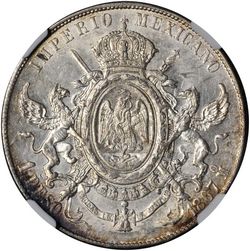
KM-388.1 1867 $1 Mexico City (Stack’s-Bowers NYINC Auction, 13 January 2018, lot 21210)
$20
The $20 gold is known in three varietiesHal Birt, Jr. “1866 Mexico Maximilian 20 Peso Gold” in La Cronica Imperial, Maximilian Numismatic Historical Society, April – July 1975. Although three obverse dies are presented here along with three reverse dies the coins appear the same at low level viewing, especially in the treatment of Maximilian.
[images needed]
Type 1
Obverse 1.
Die scratches over MAXIMILIANO.
Reverse 1.
Die cracks through IMPERIO, noticeably three from upper half of P to E..

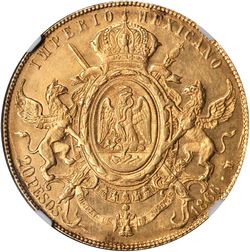
Type 2 (Stack’s-Bowers Auction, 16 August 2016, lot 21197)
Obverse 2.
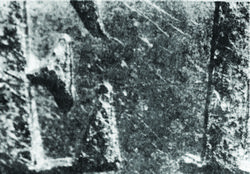
Delicate die scratch nearly half way up between E and R of EMPERADOR, tiny raised spots over EM.
Reverse 2.
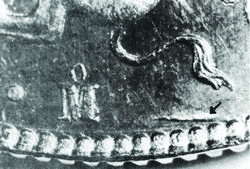
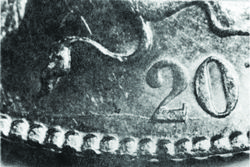
Bold, raised die crack begins at denticle under griffin’s tail, extends five denticles towards base of mint mark). Wandering die crack begins at 7:00, through base of 20, again under wing, over IMPE, continues MEXICA. Upper portion of 2 flattened.
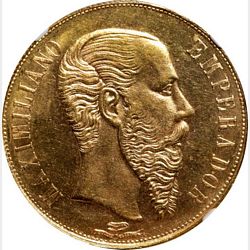

Type 3 (Stack’s-Bowers Auction, 24 February 2022, lot 74735)
Obverse 3.
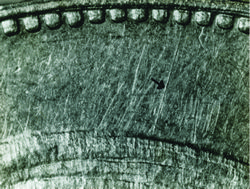
Die scratch from right third of twentieth bead at right of O in MAXIMILIANO to center of top of head.
Reverse 3.
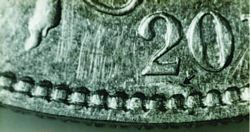
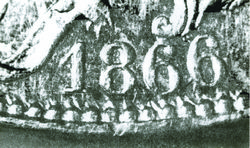
Bold die break under 2 about four denticles long, “FLAMES” under date , second S in pesos barely joined at lower curve.
Mintage
The coinage minted in Mexico City in 1864 as reported by José Antonio de Mendizabal (on behalf of John Temple} was as followsDiario de Imperio, Tomo I. Núm. 6, 8 January 1865:
| Marcos de oro de 21 quilates |
Marcos de plata de 10 ds. 20 gs |
Value of gold |
Value of silver |
Total value |
|
| January | 39,881 7 2 | $ 339,603.25 | $ 339,603.25 | ||
| February | 42,360 1 1 | 360,691.50 | 360.691.50 | ||
| March | 370 6 2 | 36,214 0 0 | 50,496.00 | 308,378.00 | 358,874.00 |
| April | 60,045 6 1 | 511,354.20 | 511,354.20 | ||
| May | 50,823 4 7 | 432,789.15 | 432,789.15 | ||
| June | 47,320 6 0 | 402,936.50 | 402,936.50 | ||
| July | 48,755 7 3 | 415,150.00 | 415,150.00 | ||
| August | 235 0 5 | 40,110 4 2 | 32,016.00 | 341,573.15 | 373,589.15 |
| September | 318 3 1 | 50,803 7 4 | 43,360.00 | 433,363.80 | 476,723.80 |
| October | 58,875 7 6 | 501,313.60 | 501,313.60 | ||
| November | 46, 020 7 2 | 399,520.55 | 399,520.55 | ||
| December | 191 4 6 | 63,245 6 3 | 26,088,00 | 538,535.50 | 564,623.50 |
| Total | 1,115 6 6 | 585,449 1 7 | $ 151.960.00 | $ 4,985,209.20 | $5,137,169.20 |
The mintage figures for the Maximilian period are not yet definitively established, which is surprising since both main sources (which differ between them) are almost contemporary. These are Orozco y Berra’s article “Acuñacion en Mexico” in El Renacimiento, vol. 1, 1869 and the printed report by M. Payno “Cuentas, Gastos, Acreedores y otros asuntos del tiempo de la intervencion francesa y del Imperio de 1861 a 1867” (Mexico, 1868), both of which are summarized following:
Figures from Orozco y Berra
| Denomination | Number of coins struck | Total value |
| 1 Peso dated 1866 | 2,147,675 | $2,147,675 |
| 1 Peso dated 1867 | 1,238,000 | 1,238,000 |
| Total of silver pesos | 3,385,675 | 3,385,675 |
| 50 Centavos | 30,150 | 15,575 |
| 20 Pesos | 8,274 | 165,480 |
| Total | $3,566,730 |
Figures from M. Payno
| Denomination | Number of coins struck | Total value |
| 1 Peso dated 1866 | ||
| 1 Peso dated 1867 | ||
| Total of silver pesos | 3,366,000 | $3,366,000 |
| 50 Centavos | 29,150 | 14,575 |
| 20 Pesos | 5,199 | 103,980 |
| Total | $3,484,555 |
In addition, Orozco y Berra gives the following mintage figures for the 5c and 10c struck at the Mexico City mint:
| Denomination | Number of coins struck | Total value |
| 5 Centavos dated 1864 | 134,254 | $6,712.70 |
| 5 Centavos dated 1865 | 127,547 | 6,377.35 |
| 5 Centavos dated 1866 | 99,606 | 4,980.30 |
| 5 Centavos dated 1867 | 8,560 | 428.00 |
| Total |
| Denomination | Number of coins struck | Total value |
| 10 Centavos dated 1864 | 138,532 | $13,853.20 |
| 10 Centavos dated 1865 | 115,557 | 11,555.70 |
| 10 Centavos dated 1866 | 92,255 | 9,225.50 |
| 10 Centavos dated 1867 | 20,001 | 2,000.10 |
| Total | 366,345 | $36,634.50 |
Guanajuato
The Guanajuato mint was occupied by the French from 8 December 1863 to 26 January 1866. This mint issued the following Maximilian coins: 5c (1864, 1865, 1866), 10c (1864, 1865 and $1 (1866).
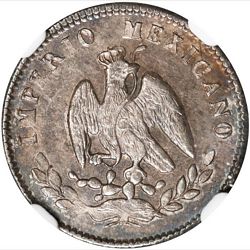
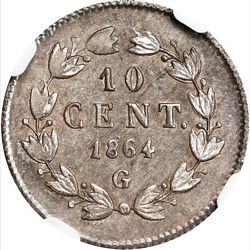
KM-386.1 10c Guanajuato (Stack’s-Bowers Auction, 28 February 2023, lot 72175)
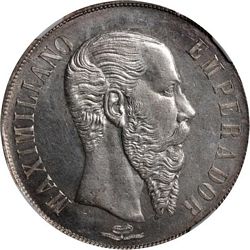
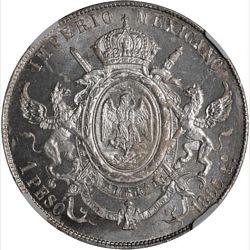
KM-388 $1 Guanajuato (Stack’s-Bowers NYINC Auction, 20 January 2022, lot 2099)
Mintage
The coinage minted in Guanajuato in 1864 as reported by the Interventor, Pantaleon Espinoza de los Monteros was as followsDiario de Imperio, Tomo I. Núm. 9, 12 January 1865:
| Denomination | Number | Total value |
| 5c | 90,000 | $ 4,500.00 |
| 6¼c (half real) | 64,000 | 4,000.00 |
| 10c | 45,000 | 4,500.00 |
| 12½c (real) | 46,400 | 5,800.00 |
| 25c | 200,000 | 50,000.00 |
| 50c (4 reales) | 115,000 | 57,500.00 |
| $1 | 3,986,900 | 3,986,900.00 |
| Onza | 34,175 | 546,800.00 |
| 4,581,475 | $ 4,660,000.00 |
All of these were Republican type, except for the Imperial 5c and 10c which would have been issued after April 1864, so the minitage of Maximilian coins was:
| Denomination | Number of coins struck | Total value |
| 5 Centavos dated 1864 | 90,000 | $4,500.00 |
| 5 Centavos dated 1865 | ||
| 5 Centavos dated 1866 | ||
| Total |
| Denomination | Number of coins struck | Total value |
| 10 Centavos dated 1864 | 45,000 | $4,500.00 |
| 10 Centavos dated 1865 | ||
| Total |
| Denomination | Number of coins struck | Total value |
| 1 Peso dated 1866 |
San Luis Potosí
The San Luis Potosí was occupied from 25 December 1863 to 25 December 1866. This mint issued three values, 5c (1864), 10c (1864) and $1 (1866).
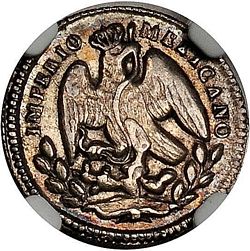

KM-385.2 5c San Luis Potosí (Stack’s-Bowers NYINC Auction, 7 January 2011, lot 72)
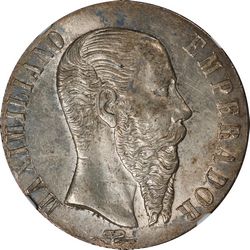
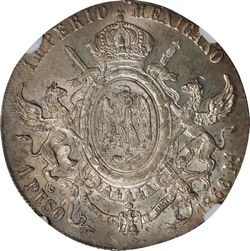
KM-388.2 $1 San Luis Potosí (Stack’s-Bowers NYINC Auction, 13 January 2023, lot 21239)
Allan Schein has identified a die clash known as "the clashed ear".
Zacatecas
The Zacatecas mint was occupied from 6 February 1864 to 29 November 1866. This mint issued two values, 5c (1865) and 10c (1865).
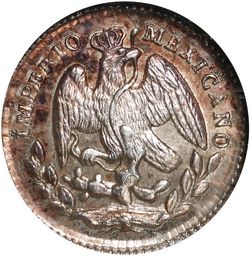
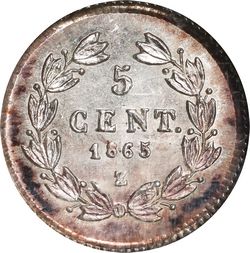
KM-386.3 5c Zacatecas (Stacks-Bowers Auction, 23 February 2023)
